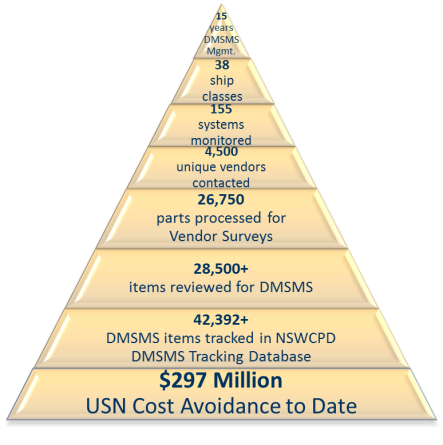A Total Systems Approach Solves and Mitigates DMSMS Problems Before U.S. Naval Fleet Feels Impact
The Naval Surface Warfare Center Philadelphia Division (NSWCPD) Code 315, Provisioning and Supply Support Branch, performs a variety of program management tasks which support U.S. Navy Hull, Machinery, and Electrical (HM&E) systems and equipment. Code 315 serves as the Diminishing Manufacturing Sources and Material Shortages (DMSMS) Management entity. It also serves as a conduit between NSWCPD’s Technical Codes/In-Service Engineering Agents (ISEAs) and the Navy’s SEA21 and PEO Program Offices for new acquisition and in-service ships. In this role, Code 315 is responsible for internally managing all pertinent and applicable cost, resources, schedule, time, technical performance, and risk associated with tasks assigned to NSWCPD related to DMSMS.
Managing DMSMS Becomes a Requirement for Navy Acquisition Programs
The Department of Defense (DoD) defines Diminishing Manufacturing Sources and Material Shortages (DMSMS) as the loss or impending loss of manufacturers, suppliers or items, or shortages of raw materials. DMSMS affects all phases of the acquisition cycle, from design and development through post-production, and has the potential to severely impact system and weapon supportability and total ownership cost (TOC).
In response to the challenge of obsolescence, in January 2005 the Assistant Secretary of the Navy (Research, Development and Acquisition) directed all Navy Acquisition Category programs to establish a formal plan for managing DMSMS. The overall objective of a viable DMSMS program is to improve the operational availability of ships and systems, and reduce future operating and support costs by minimizing the impact of spares obsolescence. Two approaches support this overall objective: proactive obsolescence management to avoid obsolescence risks; and case management of emergent obsolescence issues, to identify and select appropriate alternatives to address known obsolescence issues.
LCE Supports Proactive Obsolescence Management for NSWCPD Programs
Both the DoD and Navy require that Program Managers establish a DMSMS program to proactively identify, resolve, and eliminate any negative impacts from DMSMS throughout all phases of a Program’s life cycle. Fortunately, Life Cycle Engineering (LCE) helps Program Managers meet this requirement in innovative and cost-effective ways.
LCE performs proactive and reactive obsolescence management for all designated HM&E systems in conjunction with NSWCPD requirements within prescribed funding authorizations and schedules. This support includes program management, issue evaluation and resolution investigation, status reporting and monitoring, metrics generation, ISEA and OEM/Vendor interface, vendor surveys, supportability analyses, and asset recovery.
LCE supported NSWCPD in developing the FY 2016-2022 SEA21 Proactive Management Program Plan, and assisted in generating NSWCPD and contractor funding requirements as well as developing major DMSMS planning documents. LCE enhanced the CVN priority scheme for PMS312L and PMS378, and modified and implemented a priority scheme tailored for SEA21 Surface Combatants and Amphibious ship classes. This enabled SEA21 to identify high-priority obsolescence issues and target them for proactive monitoring, evaluation, and resolution. LCE also performed a supportability data analysis on 10 key CVN-78 Class HM&E systems and supported PMS378 in setting priorities for proactive management, resulting in cost savings for the CVN-78 New Acquisition and Life Cycle programs. Focusing on cross-platform solutions has enabled LCE to facilitate cost-sharing for common problems, resulting in lower total ownership cost and improved return on investments.
To address emergent issues associated with the ships, LCE has proactively participated in ongoing projects and evolutions, and provided timely and effective resolutions as issues emerged. For example, LCE provided research and analysis on failed equipment to identify the correct replacements for numerous obsolete components. LCE experts also made recommendations to obtain the correct Form-Fit-Function (FFF) replacements and highlighted needed corrections to the configuration database and all applicable ILS products.
Comprehensive, Cross-Platform Program Support Helps U.S. Navy Avoid Almost $300 Million in Costs
LCE has provided ongoing DMSMS proactive/reactive program and technical support to NSWCPD since program inception in 2003, and helped establish obsolescence guidance and plans for carrying out ongoing DMSMS functions for the NSWCPD.

Our support for the NSWCPD DMSMS Management Program demonstrates how LCE performs complex tasks in a cost-effective and timely manner. LCE was chosen to support this program due to our excellence in system configuration knowledge, integrated logistics support, and ability to analyze the NSWCPD Controls (Electronic Machinery and Steering) and Non-controls (Mechanical HM&E) equipment for current and predictive sustainability support issues. LCE continuously conducts health assessments and analyzed over 50 separate major systems covering 30 different ship classes. Our strong team of qualified people, cross-trained in multiple disciplines (e.g., logistics, project management, computer programming) has consistently met or beaten project deadlines while maintaining a low cost to NSWCPD. LCE also improved Department 31 communications by identifying redundant efforts and establishing cross-team processes between the DMSMS, Commonality, and the Provisioning teams to cover instances where issues need to be resolved.
LCE uses shared information across all platforms to help identify USN solutions. This approach enables LCE to attack obsolescence with an established cross-platform DMSMS/Obsolescence Program which complies with Navy regulations. LCE follows NAVSEA mandates and initiatives for resolution, including reducing Total Ownership Cost (TOC) and using Commonality principles. LCE establishes and tailors obsolescence programs to meet individual program requirements and priorities, and within prescribed funding requirements.
Since 2004, this approach has helped the U.S. Navy avoid costs of more than $297M. Demonstrated and acknowledged Obsolescence Management Performance included recognition of NSWCPD/LCE by PMS312 for the NAVSEA Total Ownership Costs Program for the Carrier Obsolescence Management Working Group (COMWG).

To learn more about LCE's ongoing naval support,
visit the Integrated Logistics Support web page.
